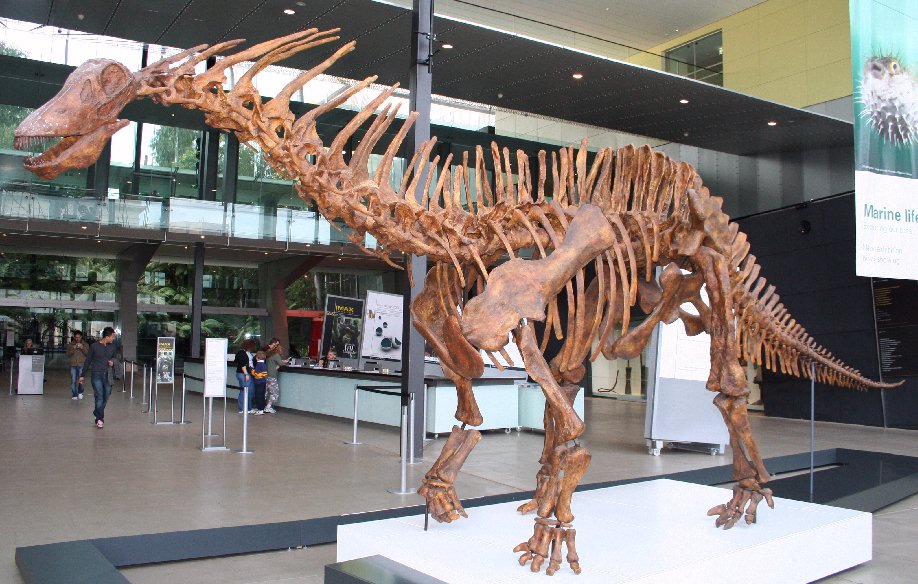
+- MacResource (https://forums.macresource.com)
+-- Forum: My Category (https://forums.macresource.com/forumdisplay.php?fid=1)
+--- Forum: Tips and Deals (https://forums.macresource.com/forumdisplay.php?fid=3)
+--- Thread: Random dinosaur posting: Amargasaurus (/showthread.php?tid=210029)
Pages:
1
2
Random dinosaur posting: Amargasaurus - pRICE cUBE - 10-22-2017

Amargasaurus is a genus of sauropod dinosaur from the Early Cretaceous epoch (129.4–122.46 mya) of what is now Argentina. The only known skeleton was discovered in 1984 and is virtually complete, including a fragmentary skull, making Amargasaurus one of the best-known sauropods of its epoch. Amargasaurus was first described in 1991 and contains a single known species, Amargasaurus cazaui. It was a large animal, but small for a sauropod, reaching 9 to 10 meters (30 to 33 feet) in length. Most distinctively, it sported two parallel rows of tall spines down its neck and back, taller than in any other known sauropod. In life, these spines most likely could have stuck out of the body as solitary structures that supported a keratinous sheath. An alternate hypothesis, now less favored, postulates that they could have formed a scaffold supporting a skin sail. They might have been used for display, combat, or defense.
Amargasaurus was discovered in sedimentary rocks of the La Amarga Formation, which dates back to the Barremian and late Aptian stages of the Early Cretaceous. A herbivore, it shared its environment with at least three other sauropod genera, which might have exploited different food sources in order to reduce competition. Amargasaurus probably fed at mid-height, as shown by the orientation of its inner ear and the articulation of its neck vertebrae, which suggest a habitual position of the snout 80 centimeters (31 inches) above the ground and a maximum height of 2.7 meters (8.9 feet). Within the Sauropoda, Amargasaurus is most closely related to the Late Jurassic genera Dicraeosaurus, Brachytrachelopan and Suuwassea. Together, these genera form the family Dicraeosauridae, which differs from other sauropods in showing shorter necks and smaller body sizes.

Re: Random dinosaur posting: Amargasaurus - NewtonMP2100 - 10-22-2017
.....if you over exercise your glutes, you will probably see an AssSoSor(e)us.......
Re: Random dinosaur posting: Amargasaurus - ka jowct - 10-22-2017
Very cool, thanks for posting.
Re: Random dinosaur posting: Amargasaurus - gabester - 10-23-2017
I know that the paleontologists know their stuff and have good reasons for doing things they way they do, but I have to wonder with dinosaurs how they can come up with all these species that look nearly identical except for different sizes and weird bone deformities why it wouldn't be more likely that there are many fewer species? Just as with humans you sometimes get six fingers or toes, or an extra set of teeth, or albinos.
Re: Random dinosaur posting: Amargasaurus - Carnos Jax - 10-23-2017
It's like you suspected, paleontologists really know their stuff. Keep in mind also, dinosaurs as a group, are comparable to mammals. There can be lots of variety in that.
Re: Random dinosaur posting: Amargasaurus - gabester - 10-23-2017
Carnos Jax wrote:
It's like you suspected, paleontologists really know their stuff. Keep in mind also, dinosaurs as a group, are comparable to mammals. There can be lots of variety in that.
Yes, I know. It still is amazing to me, and I do wonder when they have a single sample how they know it's a differentiated species and not just a mutation. Look at Rhinos... there's the one horn and the two horn. Different species. But sometimes you get an albino... just a mutation! (And not one that would show up on the fossil record...) Or, a better example, humans with dwarfism or gigantism. Still part of our species, but from a single sample in the fossil record it might make them think it was a different species entirely.
I know they have tools and methods to minimize it, it's still just fascinating. Science is truly humankind's most remarkable accomplishment!
Re: Random dinosaur posting: Amargasaurus - Speedy - 10-23-2017
Statistics dictate that this single example is considered representative of the species.
Re: Random dinosaur posting: Amargasaurus - ka jowct - 10-23-2017
The neck structures in this case don’t seem likely to have occurred in a different species that had no such structures. In any case, science sorts these things out over time.
It’s useful to keep in mind that everything we know about past life on earth is derived from a tiny fraction of what has existed.
Re: Random dinosaur posting: Amargasaurus - rjmacs - 10-23-2017
gabester wrote:
[quote=Carnos Jax]
It's like you suspected, paleontologists really know their stuff. Keep in mind also, dinosaurs as a group, are comparable to mammals. There can be lots of variety in that.
Yes, I know. It still is amazing to me, and I do wonder when they have a single sample how they know it's a differentiated species and not just a mutation. Look at Rhinos... there's the one horn and the two horn. Different species. But sometimes you get an albino... just a mutation! (And not one that would show up on the fossil record...) Or, a better example, humans with dwarfism or gigantism. Still part of our species, but from a single sample in the fossil record it might make them think it was a different species entirely.
I know they have tools and methods to minimize it, it's still just fascinating. Science is truly humankind's most remarkable accomplishment!
Remember: differences that combine to produce speciation (that is, reproductive isolation resulting from behavioral or genetic mate-restriction) all start out as mutation that propagate across generations and offer an evolutionary advantage. There's not so bright a line between the things you describe, and it takes experts to make good guesses as to which the fossil record represents.
Re: Random dinosaur posting: Amargasaurus - ka jowct - 10-23-2017
What I want is a fully isolated space-time bubble from within which the past could be explored.